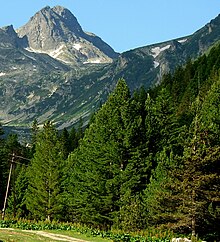Pinus peuce
| Pinus peuce | |
|---|---|

| |
| Trees in native environment, Malyovitsa, Rila Mountains, Bulgaria. | |
| Scientific classification | |
| Kingdom: | Plantae |
| Clade: | Tracheophytes |
| Division: | Pinophyta |
| Class: | Pinopsida |
| Order: | Pinales |
| Family: | Pinaceae |
| Genus: | Pinus |
| Subgenus: | P. subg. Strobus |
| Section: | P. sect. Quinquefoliae |
| Subsection: | P. subsect. Strobus |
| Species: | P. peuce
|
| Binomial name | |
| Pinus peuce Griseb.
| |

| |
| Distribution range of Pinus peuce | |
Pinus peuce (Macedonian pine[2] or Balkan pine[3]) (Serbo-Croatian/Macedonian: молика, molika; Bulgarian: бяла мура, Byala mura) is a species of pine native to the mountains of Macedonia, Bulgaria, Albania, Montenegro, Kosovo,[a] the extreme southwest of Serbia, and the extreme north of Greece,[4][5][6] growing typically at (600-) 1,000-2,200 (-2,300) m altitude. It often reaches the alpine tree line in this area. The mature size is up to 35–40 m height, and 1.5 m trunk diameter.[4][5] However, the height of the tree diminishes strongly near the upper forest limit and may even obtain shrub sizes.[7]
It is a member of the white pine group, Pinus subgenus Strobus, and like all members of that group, the leaves ('needles') are in fascicles (bundles) of five, with a deciduous sheath. They are 6–11 cm long. Its pine cones are mostly 8–16 cm long, occasionally up to 20 cm long, green at first, becoming yellow-brown when mature, with broad, flat to downcurved scales. The 6–7 mm long seeds have a 2 cm wing and can be wind-dispersed, but are also very often dispersed by spotted nutcrackers.[4][5]
Use[]
Macedonian pine is one of the most valuable conifer species in the Balkan Peninsula. Its durable wood is highly valued in construction, furniture production, wood-carving and cooperage. The tree is also exceptionally good at adapting to severe mountain climate conditions, which makes it a valuable species for afforestation on high terrain for protection against erosion. The local population use P. peuce resin to cure wounds, pectoral, skin and stomach diseases, varicose veins and other illnesses.[7]
Macedonian pine is also a popular ornamental tree in parks and large gardens, giving reliable steady though not fast growth on a wide range of sites. It is very tolerant of severe winter cold, hardy down to at least -45 °C, and also of wind exposure. It is locally naturalised Punkaharju in eastern Finland.[5]
Like other European and Asian white pines, Macedonian pine is very resistant to white pine blister rust (Cronartium ribicola).[8][9] This fungal disease was accidentally introduced from Europe into North America, where it has caused severe mortality in the American native white pines (e.g. western white pine, sugar pine, whitebark pine) in many areas. Macedonian pine is of great value for research into hybridisation and genetic modification to develop rust resistance in these species; hybrids with eastern white pine inherit some resistance.[9]
Other[]
Synonyms include Pinus cembra var. fruticosa Griseb.,[10] Pinus excelsa var. peuce (Griseb.) Beissn.,[11] Pinus peuce var. vermiculata Christ,[9] and Balkan pine.[12]

Cultivated specimen, Berlin Botanical Gardens

Foliage and cones

Young female cone
Notes[]
- ^ Kosovo is the subject of a territorial dispute between the Republic of Kosovo and the Republic of Serbia. The Republic of Kosovo unilaterally declared independence on 17 February 2008. Serbia continues to claim it as part of its own sovereign territory. The two governments began to normalise relations in 2013, as part of the 2013 Brussels Agreement. Kosovo is currently recognized as an independent state by 97 out of the 193 United Nations member states. In total, 113 UN member states are said to have recognized Kosovo at some point, of which 15 later withdrew their recognition.
References[]
- ^ Farjon, A. (2017). "Pinus peuce". IUCN Red List of Threatened Species. 2017: e.T34193A95751594. doi:10.2305/IUCN.UK.2017-2.RLTS.T34193A95751594.en.
- ^ BSBI List 2007 (xls). Botanical Society of Britain and Ireland. Archived from the original (xls) on 2015-06-26. Retrieved 2014-10-17.
- ^ Michael Dirr - Dirr's Hardy trees and shrubs: an illustrated encyclopedia, , Timber Press, 1997, ISBN 9780881924046, page. 282
- ^ Jump up to: a b c Farjon, A. (2005). Pines. Drawings and descriptions of the genus Pinus, ed.2. Brill, Leiden ISBN 90-04-13916-8.
- ^ Jump up to: a b c d Gymnosperm Database Pinus peuce
- ^ Critchfield, W. B., & Little, E. L. (1966). Geographic distribution of the pines of the World. U.S. Dept. of Agriculture Forest Service Misc. Publ. 991.
- ^ Jump up to: a b Alexandrov, A. & Andonovski, V. (2011), Macedonian pine - Pinus peuce: Technical guidelines for genetic conservation and use (PDF), European Forest Genetic Resources Programme, p. 6 pp
- ^ Søegaard, B. (1972). Relative blister rust resistance of native and introduced white pines in Europe. Pages 233–239 in Bingham, R. T. et al., eds. Biology of Rust Resistance in Forest Trees. U.S. Dept. of Agriculture Forest Service Misc. Publ. 1221.
- ^ Jump up to: a b c Popnikola, N., M. Jovancevic, and M. Vidakovic. 1978. Genetics of Pinus peuce Gris. Annales Forestales 7/6: 187-206.
- ^ "Pinus peuce". World Checklist of Selected Plant Families (WCSP). Royal Botanic Gardens, Kew.
- ^ Farjon, A. 1998. World Checklist and Bibliography of Conifers. Royal Botanic Gardens, Kew. 300 p. ISBN 1-900347-54-7.
- ^ Dirr, M. (1997). Dirr's Hardy trees and shrubs: an illustrated encyclopedia. Timber Press ISBN 978-0-88192-404-6, page. 282
External links[]
| Wikimedia Commons has media related to Pinus peuce. |
- Pinus peuce - information, genetic conservation units and related resources. European Forest Genetic Resources Programme (EUFORGEN)
- IUCN Red List near threatened species
- Pinus
- Flora of Southeastern Europe
- Flora of North Macedonia
- Flora of Bulgaria
- Flora of Albania
- Flora of Serbia
- Near threatened plants
- Near threatened biota of Europe
- Flora of Montenegro



